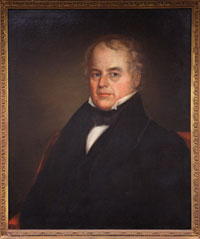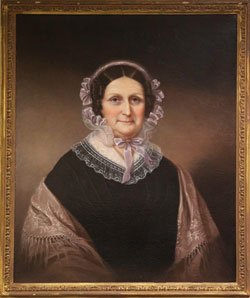A Reverend's Return
A portrait of one of GW's founders, often overshadowed, now has a presidential audience.
 He was one of GW's founding fathers, the man who symbolically leased the school its original plot of land for the price of one peppercorn annually. Now his picture hangs in the office suite of President Steven Knapp, in homage to his service during the university's earliest years.
He was one of GW's founding fathers, the man who symbolically leased the school its original plot of land for the price of one peppercorn annually. Now his picture hangs in the office suite of President Steven Knapp, in homage to his service during the university's earliest years.
The painted portraits of the Rev. Obadiah Bruen Brown and his wife, Elizabeth Riley Brown, were unveiled in December by Dr. Knapp and Russell Train, the great-great-grandson of Rev. Brown.
The portraits had been hanging for years at a Maryland farm belonging to Mr. Train and his wife, Aileen. But Mr. Train—a former judge who also has served as chairman of the World Wildlife Fund, head of the U.S. Environmental Protection Agency, and undersecretary of the Interior Department—said he thought GW would be "an appropriate home for them."
Mr. Train's ancestor Rev. Brown was among the quartet of Baptist ministers who raised money, petitioned Congress for a charter and opened the Columbian College in 1821. (It wasn't until 1904 that the school became known as George Washington University.)
He served as the inaugural head of the college's Board of Trustees and often even filled in for the school's frequently absent first president, Rev. William Staughton, according to the 1970 university history Bricks Without Straw, by Elmer Louis Kayser.
Rev. Brown also is credited with greatly aiding the school's treasurer, Rev. Luther Rice, who often was away fundraising.
 Although Rev. Rice, the namesake of GW's main administration building, would come to be considered Columbian College's "founder, defender, and chief fundraiser," wrote Dr. Kayser, without his confidant Rev. Brown, he "would have been ineffective in large degree, for [Rev.] Brown was what [Rev.] Rice was not—orderly, methodical, and practical."
Although Rev. Rice, the namesake of GW's main administration building, would come to be considered Columbian College's "founder, defender, and chief fundraiser," wrote Dr. Kayser, without his confidant Rev. Brown, he "would have been ineffective in large degree, for [Rev.] Brown was what [Rev.] Rice was not—orderly, methodical, and practical."
In raising money to open the college, the ministers were acting on behalf of a larger Baptist organization (such bonds between colleges and religions were not uncommon at the time). And although Congress had chartered the school as nondenominational, the Baptists wished to retain some authority. Rev. Brown helped them achieve that in the early years of the school.
When the ministers were able to purchase the original 46-and-a-half-acre plot of land—north of present-day Florida Avenue, between 14th and 15th streets N.W.—the deed was entrusted to Rev. Brown.
He granted the college a 1,000-year lease, "for which the Trustees were to pay one peppercorn, if demanded, on the first day of each September," wrote Dr. Kayser.
But the lease also stipulated that the Baptists would have a role in selecting some members of the Board of Trustees, and allowed the lessor to occupy a portion of the land at any time. Rev. Brown then transferred his rights under the lease to the Baptist organization.
Rev. Brown, who left the board in 1827 and died in 1853, also is remembered as the longtime leader of D.C.'s First Baptist Church, which occupied the building that would become Ford's Theatre, where President Lincoln was assassinated.
—Danny Freedman
